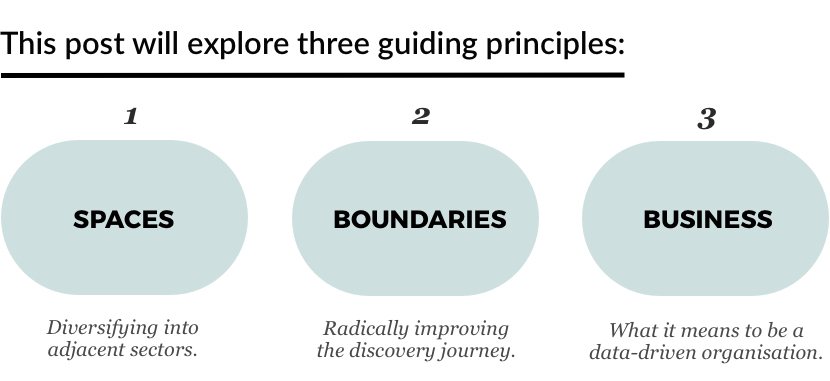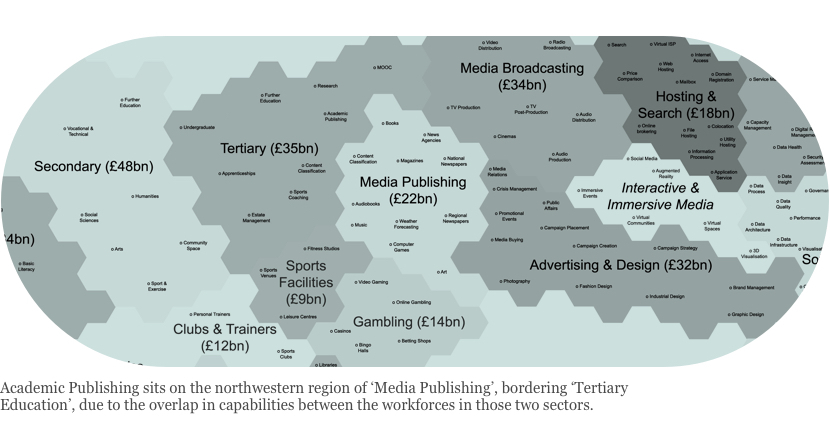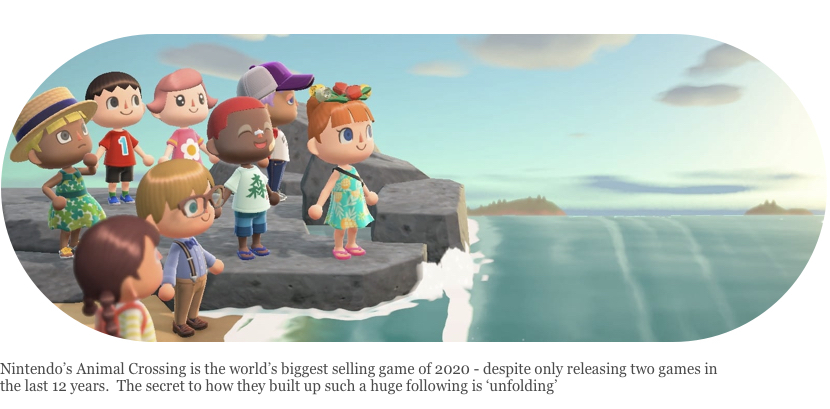Our Thinking Mon 13th July, 2020
A Roadmap for a Brighter Future in Academic Publishing
Academic publishers, along with all those involved in scholarly communications, are experiencing unprecedented change. This critical moment will have long-lasting effects, with the disruption creating threats and opportunities. This post proposes three directions publishers should consider, if they are to thrive in the new reality…
A revolutionary moment
Anyone claiming they can accurately predict the future is either a time traveller or a liar.
However, there is ample evidence emerging that the Covid-19 pandemic will cause a severe economic downturn, if not a global Depression, placing traditional business models under unparalleled pressure. Certainties now appear uncertain. It seems reasonable to predict that things will not return to the way they were before.
Often referred to as an ‘ecosystem’, the scholarly communications industry includes authors, publishers, Higher Education Institutions (HEIs), libraries, businesses, laboratories, funding bodies, governments, and more. The system is a complex, interconnected web. Budget cuts in Higher Education due to enrolment deferrals will reduce University Press subsidies. Academics will lose jobs – most likely, departments will close, if not entire universities. Library budgets will be cut, which will in turn hit publishers’ bottom lines. What affects one, affects all.
In these extraordinary circumstances, the question for leaders in academic publishing becomes: how best to respond? 
Diversification
Immersive Virtual Spaces
When shaping transformation journeys with companies of all sizes and sectors, the best approach we’ve found is to anchor the discussion with our Business Evolution Map.
Academic Publishing sits on the northwestern region of ‘Media Publishing’, bordering ‘Tertiary Education’, due to the overlap in capabilities between the workforces in those two sectors
Take a look at the map below. The most relevant border for our purposes is between Academic Publishing and the Tertiary Education sector. Universities have had their own publishing arms since 1534, and publishers have recently been opening up their own Universities. Indeed, in 2019 Pearson moved even further ‘west’ into the Secondary Education sector by co-launching an online Sixth Form College with Harrow School.
With the HE Sector being seriously disrupted, a publisher attempting a move into Tertiary Education would be like jumping from the frying pan into the fire. So what other directions does the map tell us Publishing should explore? Over the past few years, there has been a breed of CTO in Publishing who have insisted that the path to diversification is to transition into Software Development. According to the map, this is as unlikely as a University Press opening and running a successful retirement home. However, according to the map there is an intriguing journey open to publishers towards ‘Interactive & Immersive Media’.
Even before the Covid-19 pandemic, the idea of thousands of academics flying to briefly attend a conference in person was being challenged by the urgent needs of climate change. Due to budget cuts at Universities, coupled with ongoing public health concerns, all conference travel has been suspended. In this context, a question emerges:
How can Academic Publishing contribute to the effective dissemination of scholarly information in the absence of physical participation?
And more specifically:
What role can publishers play in creating immersive community events, occupying virtual spaces?
In a remote-first Higher Education model, what can publishers do to optimise teaching and learning outcomes?
With regards to ‘immersive virtual spaces’, those in Academic Publishing are well placed to claim this emerging problem, and open up a lucrative new revenue stream. At first glance, this may feel like a stretch, until you consider that within the cluster of companies that sit alongside Taylor & Francis under the Informa umbrella, there are several Events & Exhibitions businesses. And in the pre-Covid world, universities used their facilities to host a variety of events throughout the year. Virtual conferences present a valuable opportunity to those willing and able to pursue it.
The same applies to helping ensure pedagogically sound online teaching and learning in the Covid-19 era. For centuries, Higher Education has involved the student and teacher in the same room, referring to physical reading material, making notes with ink on paper. In recent decades, some of this changed, with the introduction of digital equivalents of their analogue predecessors (an eBook instead of a weighty tome in the student’s bag; a laptop instead of a notepad). With the rapid transition to online learning in Higher Education (it even has its own abbreviation now), publishers can and should rethink their role entirely. This line of thought quickly becomes radical: what if the very best way to help students achieve their learning goals is not another book, but a series of podcasts? A suite of interactive masterclasses? A virtual tour of an engineering plant?
Unfolding
In the thorny (if lucrative) textbook market, you see great inventiveness from publishers, exemplified by the publication of new editions of best-selling textbooks in shorter and shorter cycles. This strategy intentionally renders previous versions obsolete, and is intended to combat morbid symptoms such as piracy, leakage and the rampant second-hand market. Such tactics are decreasingly effective, exposing the shortcomings of the textbook business model, and leading to acts of desperation, such as failed mergers between large textbook houses. A rethink is required if better outcomes are to be achieved.
One potential solution is to ‘zig when others zag’, by borrowing an idea from Gaming (another part of the ‘Media Publishing’ sector on the map, above) – namely, the concept of ‘Unfolding’. In essence, this allows the publisher to make post-publication updates and enhancements, extending (rather than deliberately shortening) the life of the work. Small updates would be fed through automatically and for free (including errata, and other small changes to help keep the experience fresh and interesting). More significant changes (e.g. substantial new scholarship, new online supporting materials) would be available for purchase at a marginal cost.
Nintendo’s Animal Crossing is the world’s biggest selling game of 2020 – despite only releasing two games in the last 12 years. The secret to how they built up such a huge following is ‘unfolding’
With the perpetual, fixed digital equivalent of an analogue artefact showing signs of strain – for example, the growing need for asynchronous updates of different chapters within a collected work – ‘Unfolding’ is an intriguing concept. As elsewhere, it should prove effective in dislocating content updates from the traditional, print-based new edition cycle, thereby reducing costs and opening up new revenue streams.
In this scenario, the frequency of new editions, which has been ramping up over the past decade, would drop, and purchasers would instead buy a dynamic digital copy of the book with an extended lifespan. The risks inherent in producing expensive new textbooks every two-three years would be radically reduced, margins would increase whilst previously escalating prices would fall. The strain on authors, reviewers and publishing staff would ease, and most importantly, the learning experience would improve.

Discovery
Starting with first principles
Before proceeding any further, let’s agree on the following:
All those who belong to the scholarly communication ecosystem are actively working to ensure that as many different people as possible can access the right content, at the right time, in the right way.
From there, we can agree on further principles – such as, any behaviour that deliberately frustrates the dissemination of knowledge is bad. Everyone involved in the industry would agree that a library cancelling a subscription for budget reasons means we are failing in our collective mission.
A castle besieged
In his classic novel/memoir Austerlitz, W.G. Sebald examines (amongst many things) the history of fortification. Sebald elegantly analyses how the architectural principles of castles were developed in response to the technology and tactics of those trying to destroy them. Ultimately, the most heavily fortified castles became vulnerable the moment attackers could fly overhead and drop bombs from above. “Somehow we know by instinct,” he writes, “that outsize buildings cast the shadow of their own destruction before them.”
Returning to the matter in hand, proprietary publisher platforms have begun to resemble besieged castles. Outside the walls are camped such forces as SciHub, the Open Access (OA) movement, and international library consortia embarking on increasingly vexatious negotiations with content providers. The question is – could publishers hunkered down within their castles be spending their time and money better by doing something other than building, maintaining and defending ever higher and thicker (pay)walls?
Breaking down old boundaries
In the same way that we saw how the differences between the physical and virtual worlds are being dissolved by such concepts as immersive digital spaces, so other boundaries are being challenged. Three of the most important are as follows:
- Academic disciplines: In his recent article for the Scholarly Kitchen, Simon Holt spoke persuasively of ‘interdisciplinarity [becoming] the new norm’, with HSS and STEM disciplines mixing more easily than ever
- Publishing imprints: During the typical discovery use case, readers rarely care about which publisher publishes what
- In front of or behind the paywall: The OA movement is disrupting the traditional business model of valuable scholarly content existing behind a paywall, with legitimate access impossible without the individual or institution paying for it
On the last point, it was encouraging to see publishers unilaterally drop paywalls to allow access to Covid-19 related content. Yet as a rule only STEM-related content was opened up, indicating a failure to comprehend the opportunity at hand. As Bernice Housman, from the Department of Humanities at Penn State College of Medicine, recently said:
Science-based medicine is a tremendous advantage that we have in the modern world. The fact that we could sequence the genome of the coronavirus so quickly; the fact that we’re talking about a vaccine within 18 months or two years is phenomenal – all that is based on advancements in medicine. But the experience of the pandemic, the social disruption it has caused, the difficulties of discrimination and unequal treatment that the pandemic has uncovered – all that is the realm of the social world, and all of that is much more difficult to handle.
Set your content free
Pandemic or not, there is no bigger priority for publishers in the digital age than the optimisation of discovery. Therefore, instead of trying to ensure content is protected from all angles by a high and thick paywall, this issue can and should be turned on its head.
The single most transformative action that academic publishers could take would be to destroy paywalls forever, now. If publishers are to remain sustainable businesses, this may well be too radical a move. But there is now, and there is the future. In software, the ‘open source’ movement was once considered a fundamental attack on the bottom line, aimed at destroying the big software producers. Instead, open source software (and the technology companies that use it) has risen to rule the business world.
So what are the most constructive and effective options available to publishers when it comes to improving the discovery journey? One would be a more ‘porous’ paywall, which would grant non-subscribing individuals and institutions time-limited access to the content they need for a marginal cost. This would generate positive PR; broaden participation (from scholars in the developing world, from independent researchers, from smaller schools and businesses, etc); and create new revenue streams.
Another idea would be to explore how access could be indicated earlier in the research journey. In other words, the researcher should always be able to see, on the search results page, the content to which they have access.
It is a truth universally acknowledged that researchers neither start searching on, nor limit their subsequent search to, a single publisher’s platform. Instead, they cast their net wide, engaging with intermediaries such as Google Scholar, who help them navigate the entire research landscape. The problem is, the researcher still only knows if they have access to a piece of content when they hit a paywall, and are either let in or turned away.
As Olly Cooper, CEO of Researcher says: “Connecting scientists and researchers with relevant, impactful content to which they have legitimate access is still harder than it should be. The cost is an enormous number of missed opportunities for research outcomes to be inspired and progressed. At a time when the world is looking to the academic world to help solve our healthcare, economic and societal challenges, this feels like a high price to pay. Initiatives like GetFTR are a great start – but publishers need to achieve universal coverage if they are to properly untangle this problem.”
Attempts have been made in the past. Google Scholar were, a few years ago, exploring the concept of “Search Once, Read Always”, or “SORA”. Due to a lack of appetite from the major publishers, the idea never came to fruition. With hindsight, this was a missed opportunity, and should be revisited. Google and other aggregators and intermediaries are an increasingly important part of the scholarly communications ecosystem. Publishers should be investing in closer working relationships with them, to improve the discovery journey. There is nothing they could do that would have a more positive and lasting impact.
Data
What business are you in?
In the digital age, many companies, across a variety of business sectors, have made it a priority to become ‘data-driven’. This is easy enough to say, and extremely difficult to achieve.
The costs of hiring and keeping highly skilled data scientists would make most publishers blanch, let alone the myriad complexities and high costs of creating and maintaining a data lake in the cloud. That said, those publishers who are able to demonstrate the highest levels of transparency and accountability with regards to open data have a significant, positive role to play in the dissemination of knowledge – and an abiding source of competitive advantage.
Buy, Build, Borrow
It should come as a relief to publishers to admit that their traditional, core skills (and wage structures) do not lend themselves to building a comprehensive data capability. The problem of hiring and keeping the required skills, especially during these uncertain times, isn’t one for publishers to claim. Instead, they should conserve their energy (and budgets) and instead consider a simple truth: good data provides quick and reliable answers to the most important questions. In other words, hire and keep those people who have the right mindset, and buy or borrow the rest.
Conclusions
This post started by posing the question: how should publishers best respond to this unprecedented moment?
The current economic, social and cultural crisis is accelerating conversations about how businesses can survive and thrive in this new reality. Faced with a determined OA movement, transformative agreements, library budget cuts, significant student enrolment deferrals, increasingly sophisticated piracy, and a highly organised second-hand market, publishers should resist the conclusion that the answer is to build higher and thicker paywalls.
Instead, the answers lie in:
- Sustaining growth through diversification into adjacent spaces, such as virtual and immersive community events;
- Making bold decisions to ensure the discovery of, and access to, academic content is as simple as possible;
- Being evidence-led, and using data to inform decisions large and small, without overinvesting in expensive data science capabilities that could easily be bought or borrowed.
Never has it been more urgent and important for rigorous, well-evidenced, peer-reviewed scholarly thinking to be disseminated globally, in order to inform critical decisions about tomorrow. Making the right calls today will define how we best achieve those crucial aims.
Interested in discussing these ideas further? Do you have something to add, something with which you strongly agree, and/or a contrary position you wish to argue? In any and all cases, it would be great to hear from you. Start the conversation by commenting on the article in LinkedIn, or alternatively drop me a line at dcox@equalexperts.com



